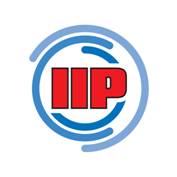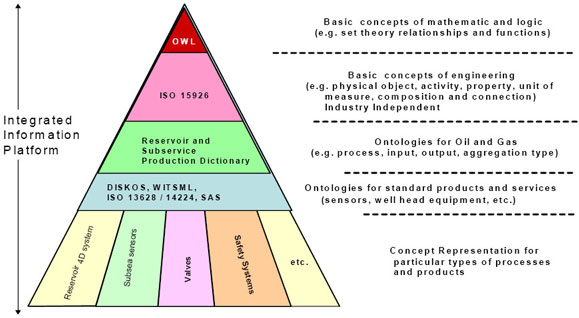Articles
ISO-15926: The purpose of ISO 15926 is to facilitate integration of data to support the lifecycle activities and processes of production facilities. To do this, this international standard specifies a data model that defines the meaning of the lifecycle information in a single context supporting all the views ...
OWL: The OWL (Web Ontology Language) is designed for use by applications that need to process the content of information instead of just presenting information to humans. OWL facilitates greater machine interpretability of Web content than that supported by XML, RDF, and RDF Schema (RDF-S) by providing additional vocabulary along with a formal semantics ...
IIP: Towards a Semantic Information Platform for Subsea Petroleum Processes [ERCIM article] ...
Relevant Links
ISO 15926 applications and information resourcesIntroduction to the Project

Project duration: April, 2004 -- June, 2007
Objective
The objective of this project is to create an integrated information platform. It will enable multi-disciplinary teams to work simultaneously in an integrated operation environment that may consist of many operation centres geographically dispersed over wide distances.The integrated information platform will be enabled by integrating several industrial data and technical standards, and also by adding new terminology. The project will also develop prototype tools for near real time off- and onshore decision support of reservoirs and subsea production facilities.
This project has the following objectives:
- To develop in an integrated information platform real time data
- To validate the information platform by establishing prototype software tools.
- To develop techniques for classifying and retrieving information using OWL ontological descriptions (Ph.D. student and Research Fellow at NTNU).
- Optimal ways to structure subsurface real time data for visualisation and decision support (NTNU Ph.D. student).
- To investigate an automatic link between the production control and reservoir simulation tools (NTNU Ph.D. student or research by operator(s)).
Research Challenges
- Integration of production, drilling, safety and automation, monitoring and operation, maintenance and reliability reservoir and subsurface information to develop an information platform.
- Linking ISO subsea class object names to RDF / OWL property names.
- Developing an OWL tool to test the information platform. This tool needs to be able to publish, process, notify, sort and collect data using the classes in the integrated information platform (Ph.D. Student and Research Fellow at NTNU).
- Develop optimal ways to structure subsurface real time data for visualisation and decision support (Ph.D. Student at NTNU).
- To investigate the possibility to establish an automatic link between the production control and reservoir simulation tools (Ph.D. Student at NTNU or research by the operator(s)).
The quality of semantics varies widely, even within ISO standards. The project will endeavour to develop a high semantic level of referenced classes. A consistent set of class structures for reservoir and subsurface systems will be added to existing class structures. RDLís from various industry and other standards will need to be integrated. Where current standards are missing reference data needed to meet the project scope, the project will develop its own Project RDL. The Project RDL will be submitted for integration with existing standards.

A Ph.D. Student and a Research Fellow from NTNUís Information System Group will investigate and develop new techniques for the following:
- Classification of documents in terms of OWL descriptions: These descriptions provide semantic summaries of the document content and reveal the documentís relationship to other documents. Both statistical and linguistic text mining techniques are needed in this process.
- Ontology-driven information retrieval: Develop new techniques that take into account the semantics of documents to improve the precision of document retrieval and better fulfil the needs of the user. This involves the use of OWL descriptions in indexing, retrieval and ranking of documents.
- Ontology-enhanced categorization and sorting: As all information is annotated with semantic OWL descriptions, the application can categorize and publish information along the semantic dimensions included in the OWL ontology. The candidate needs to investigate how this can be applied to help the user explore the domain and understand its terminology and structures.
The project team consists of: Statoil, Hydro, DNV, FMC, OilCamp, National Oilwell, Oljeindustriens Landsforening (OLF), POSC Caesar Association (POSC Caesar), IPT Dept. at NTNU, IDI dept. at NTNU.